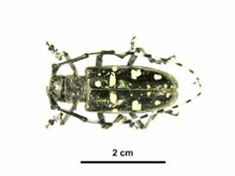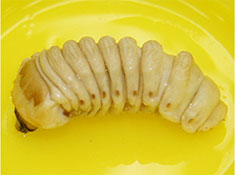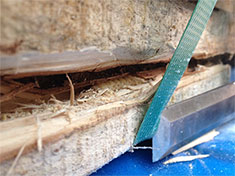Key points
- The Asian longhorn beetle is a wood-boring insect that usually targets hardwood trees, especially poplar.
- The beetle attacks both healthy trees and stressed or diseased trees.
- An adult beetle is about 20 to 35 mm long and 7 to 12 mm wide.
- Its body is jet black in colour with white spots. The antennae are black with whitish blue rings and can be up to two and a half times the body length.
Asian longhorn beetle is a wood-boring pest that usually targets hardwood trees. Poplar trees are considered the major host, but susceptibility of poplar hybrids is variable. A wide range of other trees are recorded as hosts, including alder, apple, ash, birch, elm, maple, mulberry, pear, plane tree, prunus, robinia, roses and willow. The potential effect of Asian longhorn beetle on Australian native plants is not known.
Asian longhorn beetle is indigenous to China but has spread to other countries including North Korea, South Korea and Taiwan, and is the subject of eradication campaigns in Canada and a number of states in the USA, as well as within the European Union.
Asian longhorn beetle adults chew slits in the bark of their host plants into which their eggs are inserted. Asian longhorn beetle attacks both healthy trees and stressed or diseased trees. After eggs hatch, the developing larvae feed under the bark forming tunnels that first penetrate the sapwood and later the heartwood where pupation also occurs. At the time of pupation, evidence of larval infestations appears as chewed wood or frass that has been ejected from the tunnels. Over time, the feeding activity of the larvae cause a decline in the health of trees and ultimately death. Adults cause damage by feeding on leaves and bark, with damage to the fruiting shoots of fruit trees resulting in economic loss.
What it looks like
An adult beetle is about 20 to 35 millimetres long and 7 to 12 millimetres wide. Its body is jet black in colour with white spots. The antennae are black with whitish blue rings and can be up to two and a half times the body length. The larvae look like grubs and can grow up to 50 millimetres long. Asian longhorn beetle eggs are about 5 to 7 millimetres long, off-white in colour, rectangular in shape and are laid under bark in small notches chewed out by the female. Adults can live for about a month. While they can disperse up to 400 m in a single flight, they are reported to typically lay eggs in the same tree from which they emerged, or a nearby tree. Dispersal distance over the life of an individual may be about 1.5 kilometres.




What to look for and where
The beetle is most likely to arrive in imported timber and wood used for pallets and other packing materials from Asia or North America. Look out for larval tunnels in the wood up to 15 millimetres wide, sawdust-like frass falling from damaged timber, and oval-shaped exit holes about 10 to 15 millimetres wide.
